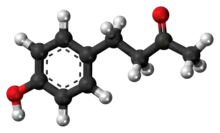Raspberry ketone
Raspberry ketone is a natural phenolic compound that is the primary aroma compound of red raspberries.
 | |
 | |
| Names | |
|---|---|
| IUPAC name
4-(4-Hydroxyphenyl)butan-2-one | |
| Other names
p-Hydroxybenzyl acetone; 4-(p-Hydroxyphenyl)-2-butanone; Frambinone; Oxyphenylon; Rheosmin; Rasketone | |
| Identifiers | |
3D model (JSmol) |
|
| Abbreviations | RK |
| ChEBI | |
| ChEMBL | |
| ChemSpider | |
| ECHA InfoCard | 100.024.370 |
| EC Number |
|
PubChem CID |
|
| UNII | |
CompTox Dashboard (EPA) |
|
| |
| |
| Properties | |
| C10H12O2 | |
| Molar mass | 164.204 g·mol−1 |
| Appearance | White needles[2] |
| Melting point | 82 to 84 °C (180 to 183 °F; 355 to 357 K) |
| Boiling point | 140 to 146 °C (284 to 295 °F; 413 to 419 K) at 0.5 mmHg |
| Hazards | |
| R-phrases (outdated) | R22 |
Except where otherwise noted, data are given for materials in their standard state (at 25 °C [77 °F], 100 kPa). | |
| Infobox references | |
Occurrence
Raspberry ketone occurs in a variety of fruits, including raspberries, cranberries, and blackberries.[3] It is biosynthesized from coumaroyl-CoA.[4] It can be extracted from the fruit, yielding about 1–4 mg per kg of raspberries.[5]
Preparation
Since the natural abundance of raspberry ketone is very low, it is prepared industrially by a variety of methods from chemical intermediates.[6] One of the ways this can be done is through a crossed aldol condensation followed by catalytic hydrogenation. First, acetone is condensed with 4-hydroxybenzaldehyde to form an α,β-unsaturated ketone. Then the alkene part is reduced to the alkane. This two-step method produces raspberry ketone in 99% yield.[7] There is a less expensive hydrogenation catalyst, nickel boride, which also demonstrates high selectivity towards hydrogenation of the double bond of enone.[8]
Uses
Raspberry ketone is sometimes used in perfumery, in cosmetics, and as a food additive to impart a fruity odor. It is one of the most expensive natural flavor components used in the food industry. The natural compound can cost as much as $20,000 per kg.[5] Synthetic raspberry ketone is cheaper, with estimates ranging from a couple of dollars per pound[9] to one fifth of the cost of the natural product.
Marketing
Although products containing this compound are marketed for weight loss, there is no clinical evidence for this effect in humans.[10]
Safety
Little is known about the long-term safety of raspberry ketone supplements,[11][12] especially since little research has been done with humans.[13] Because it is chemically related to the stimulant synephrine, there are some concerns about its safety.[10] Toxicological models indicate a potential for cardiotoxic effects, as well as effects on reproduction and development.[11] Furthermore, in many dietary supplements containing raspberry ketones, manufacturers add other ingredients such as caffeine which may have unsafe effects.[13]
In 1965, the US Food and Drug Administration classified raspberry ketone as generally recognized as safe (GRAS) for the small quantities used to flavor foods.[2]
See also
References
- Catalog of Organics and Fine Chemicals, Acros Organics, 2004/05, page 1250.
- "4-(p-Hydroxyphenyl)-2-butanone". Food and Cosmetics Toxicology. 16: 781–2. 1978. doi:10.1016/S0015-6264(78)80113-8.
- Raspberry Ketone, Molecule of the Month, University of Bristol
- "MetaCyc Pathway: raspberry ketone biosynthesis". MetaCyc. Retrieved 2012-07-12.
- Beekwilder, Jules; Van Der Meer, Ingrid M.; Sibbesen, Ole; Broekgaarden, Mans; Qvist, Ingmar; Mikkelsen, Joern D.; Hall, Robert D. (2007). "Microbial production of natural raspberry ketone". Biotechnology Journal. 2 (10): 1270–9. doi:10.1002/biot.200700076. PMID 17722151.
- Tateiwa, Jun-Ichi; Horiuchi, Hiroki; Hashimoto, Keiji; Yamauchi, Takayoshi; Uemura, Sakae (1994). "Cation-Exchanged Montmorillonite-Catalyzed Facile Friedel-Crafts Alkylation of Hydroxy and Methoxy Aromatics with 4-Hydroxybutan-2-one to Produce Raspberry Ketone and Some Pharmaceutically Active Compounds". The Journal of Organic Chemistry. 59 (20): 5901–4. doi:10.1021/jo00099a017.
- Smith, Leverett R. (1996). "Rheosmin ('Raspberry Ketone') and Zingerone, and Their Preparation by Crossed Aldol-Catalytic Hydrogenation Sequences". The Chemical Educator. 1 (3): 1–18. doi:10.1007/s00897960034a. S2CID 94729547.
- Bandarenko, Mikhail; Kovalenko, Vitaly (2014). "Synthesis of Raspberry and Ginger Ketones by Nickel Boride-catalyzed Hydrogenation of 4-Arylbut-3-en-2-ones". Zeitschrift für Naturforschung B. 69b (8): 885–888. doi:10.5560/ZNB.2014-4118.
- "Archived copy". Archived from the original on 2013-03-17. Retrieved 2012-11-06.CS1 maint: archived copy as title (link)
- "Raspberry Ketone". WebMD.
- Bredsdorff L, Wedebye EB, Nikolov NG, Hallas-Møller T, Pilegaard K (2015). "Raspberry ketone in food supplements - High intake, few toxicity data - A cause for safety concern?". Regul Toxicol Pharmacol. 73 (1): 196–200. doi:10.1016/j.yrtph.2015.06.022. PMID 26160596.
- Cathy Wong. "Raspberry Ketones for Weight Loss". About.com.
- Canberra, Jules. "What's All The Hype About Raspberry Ketone?". Authority Health. Retrieved 30 October 2017.

